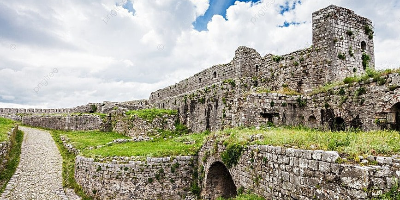Slavic Migrations into the Balkans (1 Jan 550 Jahr – 1 Jan 850 Jahr)
Beschreibung:
The Slavs who settled in the Balkans were divided into two groups, Antae and Sclaveni. Small groups of Slavs had probably participated in the campaigns of the Huns and Germanic tribes since the end of the 5th century.[6][7] The first certain Slavic raids date to the early 6th century during the time of the Eastern Roman Emperor Justin I (518–527), coinciding with the end of the Vitalian revolt (511–518).[8] Procopius recorded that in 518 a large army of the Antae, "who dwell close to the Sclaveni", crossed the Danube river into Roman territory. They continued with ever-faster and stronger incursions during the time of Justinian I (527–565),[9] with Procopius recording that the whole of Illyricum and Thrace was pillaged almost every year by Huns,[nb 1] Sclaveni, and Antae, who did enormous damage to the native Roman population, making the region a "Scythian desert".[12] As the Danubian Limes lacked garrisons, Justinian I made an alliance with the Antae to stop barbarian intrusions in Antae territory in the Lower Danube. This caused more Slavic intrusions from the region of Podunavlje, but was also followed by peaceful permanent settlement on Byzantine territory, which began in 550 or 551.[13] Things changed with the arrival of the Pannonian Avars, who fought against the Antae and subjugated masses of both Antae and Sclaveni. After the death of Justinian I, the new Roman Emperor Justin II (565–574) halted the payment of subsidies to the Avars, which sparked an almost century-long war. With the Byzantines preoccupied with the 572–591 and 602–628 wars with the Sasanian Empire, Avars and Slavs made devastating intrusions from Northern Italy to Southern Greece, and by the 7th century, the Slavs had settled in all the Balkans and Peloponnese. Roman Emperor Maurice in his Balkan campaigns (582–602) did not manage to stop the successful sieges of Sirmium, Viminacium and Thessalonica, or the destruction of various cities including Justiniana Prima and Salona, culminating with the Siege of Constantinople (626).[14][15]According to Procopius, Slavic social and political organization was a kind of demokratia in which the tribal community was ruled by the council of nobles. This allowed them to stay together regardless of environmental factors, but according to Johannes Koder, "impeded coordinated military resistance against the enemy", which put them in a situation of being under foreign political leadership.[15][16] When the Slavs and later the Avars entered the Balkans they didn't have advanced siege warfare, but around 587 they acquired this knowledge from contact with Byzantine culture, and because of this no urban settlement or fort could oppose them any more.[17] With the destruction of Roman fortifications came a loss of Byzantine military and administrative power in Roman provinces. The native population was often decimated, and the devastated lands were resettled by smaller or larger groups of Slavs. Settlement among the natives, often replacing them, happened in the autumn, when winter supplies were secured for the people and animals. After mixing with the natives who survived in smaller communities, depending on the region, the Slavic tribes mostly had names of toponymic origin.[18]
They densely populated the Balkans, more precisely the Praetorian prefecture of Illyricum:
in the late Roman province of Noricum was the Slavic settlement of the Eastern Alps (including Carantanians)
in Pannonia were the Pannonian Slavs (with Pannonian Dulebes)
the province of Dalmatia was settled by the White Croats (and Guduscani), Serbs, Narentines, Zachlumians, Travunijans, and Kanalites
Praevalitana was settled by Diocleans
the provinces of Moesia and Dardania were inhabited by Merehani, Braničevci, Timočani and Praedenecenti
provinces of Dacia Ripensis and Moesia Secunda were inhabited by Seven Slavic tribes and Severians
in part of the Diocese of Thrace were Smolyani, and Strymonites
in all of the Diocese of Macedonia were numerous tribes of Drougoubitai, Berziti, Sagudates, Rhynchinoi, Baiounitai, Belegezites, Melingoi and Ezeritai
Some Slavs in Thrace were also relocated to Anatolia, later known as Asia Minor Slavs.[19]
However, after the settlement of the Slavs, the Balkans turned to paganism and entered the Dark Ages, in which most of Europe had been until then. Many Slavs soon began to accept the cultural customs of the highly civilized Byzantine provinces,[7] and in order to expand their cultural and state influence on the South Slavs, the Byzantines began the process of Christianization.[20] The weak Eastern Roman Empire during the 7th and 8th centuries and its absence as a European power enabled the formation of a new empire in Western Europe.
Eventually the Slavs settled in the late Roman provinces of Pannonia and Dalmatia reached a substantial amount of autonomy or independence, establishing Sklavinias influenced by both Francia and Byzantine Empire. In most part of the former diocese of Dacia and Thracia the Sklavinias fell under the rule of the First Bulgarian Empire, while in the diocese of Macedonia (Southern Balkans and Peloponnese) they lacked political organization, because of which the Byzantine Empire regained control and after 200 years they became assimilated by the Greek-speaking majority, and on the territory of today's Albania by the Albanian-speaking majority.[21][22][23]
Zugefügt zum Band der Zeit:
Datum:
1 Jan 550 Jahr
1 Jan 850 Jahr
~ 300 years
